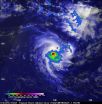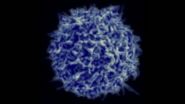GPM measured Tropical Storm Adjali's rainfall before dissipation
2014-11-20
(Press-News.org) Moderate rainfall was occurring around the center of Tropical Storm Adjali before it dissipated, according to data from NASA and the Japan Aerospace Exploration Agency's Global Precipitation Measurement or GPM satellites.
Adjali became the first named storm of the Southwest Indian Ocean 2014/2015 cyclone season when it formed on November 16, 2014. Adjali became a strong tropical storm the next day and just two days later started to dissipate.
The GPM observatory captured data on Adjali's rainfall rates on Nov. 18. GPM's Microwave Imager (GMI) instrument is similar to the Tropical Rainfall Measuring Mission's (TRMM's) Microwave Imager (TMI) which also provide rainfall rates of storms, but TRMM is limited to the tropics while GPM provides near real time global coverage of precipitation.
When GPM flew over Adjali on November 18, 2014 at 0726 UTC (2:26 a.m. EST), GPM's Microwave Imager (GMI) instrument collected data on the rate in which rainfall was occurring. GMI data showed that rain was falling at a rate of over 69 mm/about 2.7 inches per hour near the center of the tropical storm.
To create a total picture of the storm, the GPM rainfall data was combined with a visible/infrared image of Adjali's clouds as seen from Europe's METEOSAT-7 on November 18, 2014 at 0730 UTC. That image was created at NASA's Goddard Space Flight Center in Greenbelt, Maryland.
Late on Nov. 19 the atmospheric conditions around Tropical Cyclone Adjali became hostile as wind shear increased and tore the storm apart. At 2100 UTC (4 p.m. EST) the Joint Typhoon Warning Center (JTWC) issued their final bulletin on the storm. At that time, Tropical Cyclone Adjali was centered near 13.3 south latitude and 70.0 east longitude, about 400 nautical miles south-southwest of the island of Diego Garcia. It was moving to the west-northwest at 4 knots (4.6 mph/7.4 kph) and had maximum sustained winds near 35 knots (40 mph/64 kph). The JTWC noted at that time that "Adjali is currently dissipating under hostile conditions."
By November 20, Adjali had dissipated in the Southern Indian Ocean putting an end to the first tropical cyclone of the Southern Indian Ocean season.
VIDEO:
This animation shows GMI rainfall data on Tropical Storm Adjali on Nov. 19, 2014 combined with cloud data from the METEOSAT-7 satellite. Rainfall was found to be falling at a...
Click here for more information.
Global Precipitation Measurement (GPM) is an international satellite mission that will set a new standard for precipitation measurements from space, providing the next-generation observations of rain and snow worldwide every three hours. The GPM mission data will advance our understanding of the water and energy cycles and extend the use of precipitation data to directly benefit society. For more information about GPM, visit: http://www.nasa.gov/gpm
INFORMATION:
Harold F. Pierce / Rob Gutro
SSAI/NASA Goddard Space Flight Center
ELSE PRESS RELEASES FROM THIS DATE:
2014-11-20
This new survey was released November 19 as a Web First by Health Affairs. The full text is available free until November 26.
International Survey Of Older Adults Finds Shortcomings In Access, Coordination, And Patient-Centered Care
By Robin Osborn, Donald Moulds, David Squires, Michelle M. Doty, and Chloe Anderson
All authors are affiliated with The Commonwealth Fund in New York.
This study was supported by The Commonwealth Fund and also will appear in the December issue of Health Affairs.
The study surveyed 15,617 adults ages sixty-five and older in Australia, ...
2014-11-20
In many firms sales people spend as much time negotiating internally for lower prices as they do interacting with customers. A new study appearing in the November issue of Marketing Science, a publication of the Institute for Operations Research and the Management Sciences (INFORMS) finds that firms should allow their sales people to "waste" energy on internal negotiations. In fact, it says, firms should make the process wasteful on purpose.
The study, "Why do sales people spend so much time lobbying for low prices?" was conducted by Duncan Simester, the Nanyang Technological ...
2014-11-20
When blood vessels are damaged through surgery, it can trigger an endless cycle of scarring and repair.
"Scar tissue will always form inside the blood vessel and, in many cases, eventually block blood flow," said Guillermo Ameer, professor of biomedical engineering at Northwestern University's McCormick School of Engineering. "Then surgeons have to go back in, eliminate the obstruction, or put in a new graft or stent to restore blood flow. In the case of a prosthetic vascular graft used for bypass surgery, it will scar again and ultimately fail."
Ameer, who is also ...
2014-11-20
High blood pressure is a leading cause of death around the world, and its prevalence continues to rise. A study published by Cell Press on November 20th in the journal Immunity shows that a protein in the spleen called placental growth factor (PlGF) plays a critical role in activating a harmful immune response that leads to the onset of high blood pressure in mice. The findings pave the way for the development of more effective treatments for this common and deadly condition.
High blood pressure, also known as hypertension, affects more than 1 billion people worldwide ...
2014-11-20
The portion of the adult brain responsible for complex thought, known as the cerebral cortex, lacks the ability to replace neurons that die as a result of Alzheimer's disease, stroke, and other devastating diseases. A study in the International Society for Stem Cell Research's journal Stem Cell Reports, published by Cell Press on November 20 shows that a Sox2 protein, alone or in combination with another protein, Ascl1, can cause nonneuronal cells, called NG2 glia, to turn into neurons in the injured cerebral cortex of adult mice. The findings reveal that NG2 glia represent ...
2014-11-20
As we age, we have an increasingly harder time ignoring distractions. But new research online November 20 in the Cell Press journal Neuron reveals that by learning to make discriminations of a sound amidst progressively more disruptive distractions, we can diminish our distractibility. A similar strategy might also help children with attention deficits or individuals with other mental challenges.
Distractibility, or the inability to sustain focus on a goal due to attention to irrelevant stimuli, can have a negative effect on basic daily activities, and it is a hallmark ...
2014-11-20
CINCINNATI - Researchers have successfully targeted an important molecular pathway that fuels a variety of cancers and related developmental syndromes called "Rasopathies."
Reporting their results Nov. 20 in Chemistry & Biology, scientists at Cincinnati Children's Hospital Medical Center say they identified a class of lead compounds that successfully recognize a key target in the Ras signaling pathway - opening the door to future development of therapies that could make treatments more effective with fewer side effects.
Although still in the early stages of the development ...
2014-11-20
While investigating a rare genetic disorder, researchers at the University of California, San Diego School of Medicine have discovered that a ubiquitous signaling molecule is crucial to cellular reprogramming, a finding with significant implications for stem cell-based regenerative medicine, wound repair therapies and potential cancer treatments.
The findings are published in the Nov. 20 online issue of Cell Reports.
Karl Willert, PhD, assistant professor in the Department of Cellular and Molecular Medicine, and colleagues were attempting to use induced pluripotent ...
2014-11-20
VIDEO:
Researchers at the Salk Institute explain how a new technology, called ReBiL, can spot protein interactions more accurately, providing a new tool for cancer and other drug diagnostics.
Click here for more information.
LA JOLLA--For decades, researchers have struggled to translate basic scientific discoveries about cancer into therapeutics that effectively--and with minimal side effects--shrink a tumor.
One avenue that may hold great potential is the development of ...
2014-11-20
Researchers at the RIKEN Brain Science Institute in Japan have identified a key neuronal pathway that makes learning to avoid unpleasant situations possible. Published online in the November 20 issue of Neuron, the work shows that avoidance learning requires neural activity in the habenula representing changes in future expectations.
Learning to avoid threats is an essential survival skill for both humans and animals. To do so, animals must be able to predict a danger and then update their predictions based on their actions and new outcomes. Until now, the neural mechanisms ...
LAST 30 PRESS RELEASES:
[Press-News.org] GPM measured Tropical Storm Adjali's rainfall before dissipation



